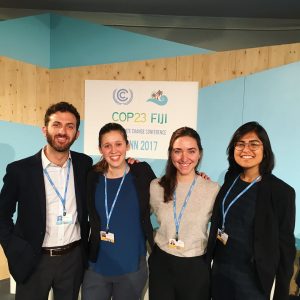As I reflect on my time at the negotiations, I am inspired by all of the messages of hope that I have heard.
During my last few days at the COP, I was able to hear Al Gore speak. His talk outlined what may be at stake if the world does not come together to meet the Paris Agreement and cap warming at 2° C. Rare extreme weather events like the recent hurricanes that hit the southeastern United States and the Caribbean are expected to occur more frequently as sea surface temperatures rise, effectively “priming the pump” for larger storms.[1] Agriculture around the world is predicted to be greatly impacted due to the changing productivity of crops and livestock from weather related stressors.[2] The United Nations High Commissioner for Refugees predicts that “50 to 200 million people will be forced out of their homes because of climate change by 2050”.[3] However, while it is important and sobering to focus on why the world needs to come together to take action, the even larger message of the COP was one of hope and opportunity.

The Duke group at Al Gore’s talk
Hope is a motivating factor and, from what I witnessed during my week at the negotiations, there is a lot to feel hopeful about. A wave of clean energy is moving across the world. In his talk, Gore highlighted that in 2000, the best projections were that the world would install 30 gigawatts of wind energy by 2010. This projection was beat 14.5 times over. Solar energy has grown even more dramatically. The worldwide projection for 2010 was 1 gigawatt of solar. In 2010, the installations were 17 times higher than what was predicted. Last year, in 2016, the world installed 75 gigawatts of solar.[4]
Even without federal leadership there is momentum moving the United States in the right direction. Throughout the week, I had an opportunity to sit in on numerous panels discussing policies at all levels of government and from the private sector to transition to cleaner energy sources. Even without new federal policies, wind and solar are now more cost competitive than coal in the United States. During the COP, the America’s Pledge Report was released which estimated that the “We Are Still In” coalition currently represents more than half of the U.S. economy. If it were its own country, the coalition would be the third largest economy in the world. While no substitute for federal action, this was encouraging to hear. While the majority of countries around the world still have a long way to go in order to meet their targets and more aggressive action is necessary, things are moving in a hopeful direction.
[1] https://www.npr.org/sections/thetwo-way/2017/09/08/549280066/hurricanes-are-sweeping-the-atlantic-whats-the-role-of-climate-change?utm_source=facebook.com&utm_medium=social&utm_campaign=npr&utm_term=nprnews&utm_content=20170908
[2] https://www.ers.usda.gov/topics/natural-resources-environment/climate-change/agriculture-and-climate-change/
[3] https://www.washingtonpost.com/news/worldviews/wp/2017/10/31/a-proposal-in-new-zealand-could-trigger-the-era-of-climate-change-refugees/?utm_term=.da4e16858df5
[4]https://www.greentechmedia.com/articles/read/iea-global-installed-pv-capacity-leaps-to-303-gw#gs.ZJybGYI

Nice overview, this is a good perspective and welcome change from the mostly negative news that seems to get the most attention. I love the spirit of the rebels who will continue to do what’s right regardless of political and/or financial pressures. California’s rebuke of Trump’s EPA emissions rollback is a prime example. Thank god there are more sane countries than one’s acting like the spoiled child that are administration is right now.
We need more people like you- Thanks.